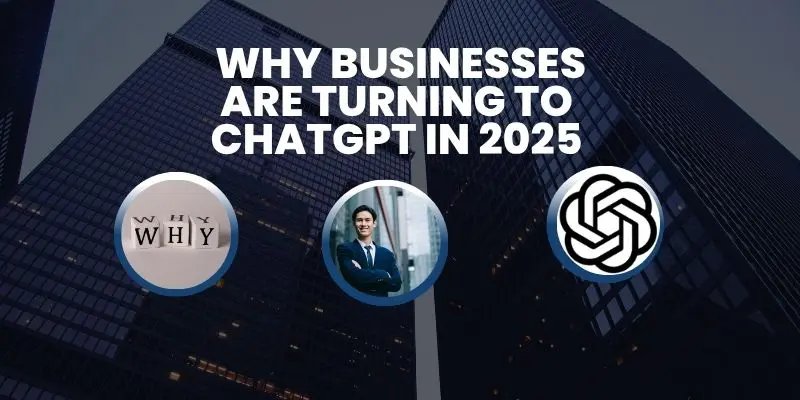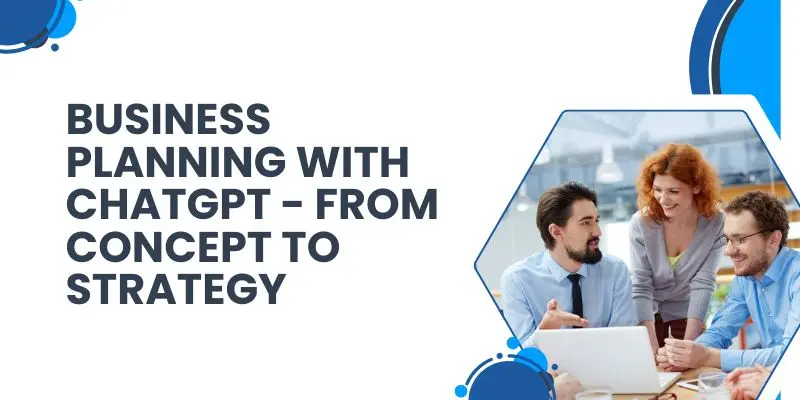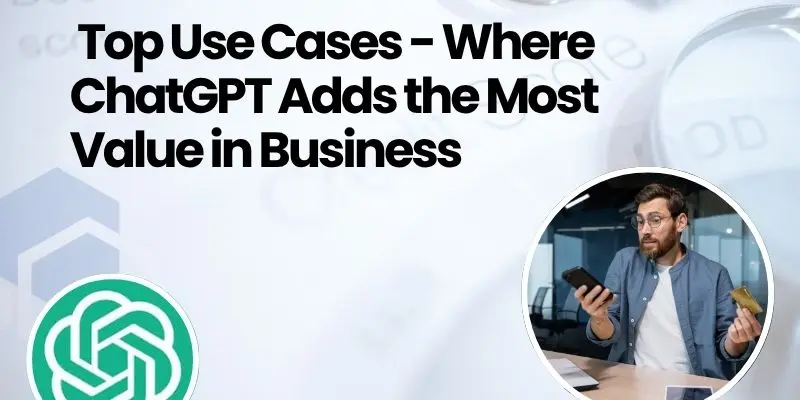How to Use ChatGPT for Business: 10 Proven Ways to Save Time, Boost Growth & Work Smarter in This Year
Published: 03 Jul 2025
AI is no longer a futuristic idea; it’s a business essential. ChatGPT is helping teams save time, cut costs, and boost productivity. From startups to enterprises, companies are using it to simplify tasks, generate content, and make smarter decisions. If you don’t know how to use ChatGPT for business, you’re already behind. This guide will show you exactly how to use it to grow your business fast.
1. Why Businesses Are Turning to ChatGPT in 2025
In 2025, ChatGPT has become more than just a chatbot; it’s a versatile business tool. As AI continues to evolve, companies are discovering new ways to automate, optimize, and scale their operations using ChatGPT. Its ability to understand language, generate content, solve problems, and learn from prompts makes it a powerful assistant across industries.

With rising labor costs and growing demand for speed and accuracy, businesses need tools that deliver results fast. ChatGPT offers exactly that. Whether it’s generating ideas, summarizing documents, drafting emails, or analyzing data, it helps teams get more done in less time.
Innovation is also a key driver. Businesses are using ChatGPT to explore new markets, personalize customer interactions, and even test product ideas before launch. It’s not just about doing the same work faster; it’s about rethinking what’s possible.
Most importantly, ChatGPT levels the playing field. Small businesses can now access capabilities that were once only available to large enterprises with big budgets. AI is no longer optional. It’s the competitive edge that defines success in 2025.
2. Laying the Groundwork – Choosing a Profitable Problem to Solve
Every successful business starts with one thing: solving a real problem. But finding the right problem, one that people are willing to pay to fix, isn’t always easy. That’s where ChatGPT can be a game-changer.
You can start by asking ChatGPT to identify emerging trends in a specific industry. For example, prompts like “What are common pain points for remote teams in 2025?” or “What problems do small eCommerce businesses face?” can help uncover real-world challenges worth solving.
Once you have a list of potential problems, go deeper. Use ChatGPT to analyze market demand and suggest business models. Ask it to compare solutions already on the market, highlight gaps, and even simulate customer personas.
You can also validate ideas quickly. Prompts like “Give me 5 reasons why people might pay for an app that simplifies meal planning” help you test demand without spending weeks on research.
For aspiring entrepreneurs or early-stage startups, ChatGPT becomes a brainstorming partner. It can generate niche ideas, segment your audience, or help refine a vague concept into something viable.
3. Business Planning with ChatGPT – From Concept to Strategy
Once you’ve identified a profitable problem, the next step is turning your idea into a structured business plan. This is where ChatGPT becomes more than a brainstorming tool it acts like a strategic planner.

Start by asking ChatGPT to outline a basic business plan. You can use prompts like:
“Create a simple business plan for a subscription box service for fitness enthusiasts.”
ChatGPT can give you a structure covering your mission, target audience, product offering, pricing, and competitive edge.
Need to set clear goals? Ask:
“List SMART goals for launching a digital marketing agency in 2025.”
ChatGPT helps define Specific, Measurable, Achievable, Relevant, and Time-bound goals to keep you focused.
Next, move on to operational planning. With the right prompts, ChatGPT can help you list what tools, platforms, and processes you need. For example:
“What tools do I need to run a remote design agency?” or
“Outline the steps to onboard new freelance team members.”
For a go-to-market strategy, ChatGPT can help build launch plans, marketing funnels, and customer acquisition tactics. Prompts like:
“Suggest a launch strategy for an AI-powered productivity app” or
“How can I attract my first 100 users without paid ads?” can return practical, actionable advice.
You can even ask it to simulate competitor research or help draft a pitch for investors.
4 . Business Planning with ChatGPT – From Concept to Strategy
Once you’ve identified a profitable problem, the next step is turning your idea into a structured business plan. This is where ChatGPT becomes more than a brainstorming tool it acts like a strategic planner.
Start by asking ChatGPT to outline a basic business plan. You can use prompts like:
“Create a simple business plan for a subscription box service for fitness enthusiasts.”
ChatGPT can give you a structure covering your mission, target audience, product offering, pricing, and competitive edge.
Need to set clear goals? Ask:
“List SMART goals for launching a digital marketing agency in 2025.”
ChatGPT helps define Specific, Measurable, Achievable, Relevant, and Time-bound goals to keep you focused.
Next, move on to operational planning. With the right prompts, ChatGPT can help you list what tools, platforms, and processes you need. For example:
“What tools do I need to run a remote design agency?” or
“Outline the steps to onboard new freelance team members.”
For a go-to-market strategy, ChatGPT can help build launch plans, marketing funnels, and customer acquisition tactics. Prompts like:
“Suggest a launch strategy for an AI-powered productivity app” or
“How can I attract my first 100 users without paid ads?” can return practical, actionable advice.
You can even ask it to simulate competitor research or help draft a pitch for investors.
5 . Top Use Cases – Where ChatGPT Adds the Most Value in Business
ChatGPT is more than a novelty; it’s a practical, everyday tool for solving real business problems.

Here are the top areas where it’s delivering measurable value to companies of all sizes:
1. Content Creation
From blog posts and social media captions to email newsletters and product descriptions, ChatGPT is a powerful writing assistant and one of the leading AI tools for content creation. You can generate first drafts, repurpose existing content, or refine tone and style to match your brand voice. It’s fast, consistent, and reduces the need for outsourcing.
Prompt example:
“Write a 500-word blog post on the benefits of AI in logistics.”
2. Customer Support
ChatGPT can be trained or fine-tuned to respond to common customer queries through chatbots, help desks, or email automation. It provides instant, 24/7 support, improving customer satisfaction and reducing workload on human agents.
Prompt example:
“Create polite responses to common refund request emails.”
3. Marketing & Advertising
AI-driven copywriting can speed up campaign development. ChatGPT can help write Facebook ad copy, brainstorm taglines, and develop full email funnels. It can even tailor messaging for different audience segments.
Prompt example:
“Generate 3 Google ad headlines for a new skincare brand targeting Gen Z.”
4. Data Analysis & Reporting
While ChatGPT doesn’t replace spreadsheets or BI tools, it’s excellent at interpreting and summarizing data. Paste your raw data (or summaries), and it can help generate reports, explain patterns, or turn insights into action plans.
Prompt example:
“Summarize the trends from this quarterly sales report.”
5. Market Research
Instead of spending hours searching online, ChatGPT can help you gather industry insights, competitor analysis, and target audience profiles in minutes. It’s great for idea validation and exploring unfamiliar markets.
Prompt example:
“Compare the top 3 productivity tools for remote teams and list pros and cons.”
6. Employee Training & Onboarding
You can use ChatGPT to develop training materials, onboarding checklists, and even quiz-style learning tools for new hires. It ensures consistent delivery and saves HR and managers valuable time.
Prompt example:
“Create a 5-day onboarding guide for new remote software developers.”
7. Coding & Technical Assistance
Developers use ChatGPT to generate boilerplate code, debug errors, write documentation, and translate between coding languages. It doesn’t replace engineers, but it certainly makes them faster and more efficient.
Prompt example:
“Write a Python script that automatically renames and organizes files by date.”
8. Knowledge Management & Organization
ChatGPT helps structure messy ideas, categorize documents, and generate summaries from long files. Whether you’re preparing slides, sorting research, or writing SOPs, it can keep your team organized and focused.
Prompt example:
“Summarize this 10-page product manual into bullet points for a training session.”
In every case, the key is not just using ChatGPT but using it strategically. These tasks, when multiplied across a business, save hours each week and unlock creativity that drives real growth.
Prompt Engineering – Crafting Better Questions for Better Results
(Just a heads-up, the second line in your message repeats a previous instruction, but no worries, I’ll continue with this section.)
6. Prompt Engineering: Crafting Better Questions for Better Results
Using ChatGPT effectively isn’t just about typing a question. It’s about asking the right question the right way. That’s where prompt engineering comes in, a growing skill that’s quickly becoming essential for AI-driven work.
A well-crafted prompt leads to clearer, more useful, and more targeted responses. A vague question gets vague answers. But a specific, structured prompt gives you actionable insights. It’s like giving directions: the more precise you are, the faster you get where you want to go.
Let’s look at an example:
Poor prompt: “Write me an ad.”
Better prompt: “Write a 2-line Facebook ad for a budget travel app targeting college students, using a casual tone.”
That small change gives ChatGPT context, tone, purpose, and audience—all of which help it respond more effectively.
Here are a few tips for better prompts:
Be specific: Mention the format, length, tone, and target audience.
Give context: Tell the model what the task is for (e.g., social media, investor pitch, training guide).
Use examples: Provide a short sample or style guide if possible.
Break down complex tasks: Ask one question at a time, or step-by-step.
Prompt engineering is already becoming a must-have skill for marketers, managers, developers, and creators. Knowing how to “talk” to AI increases the quality of your outputs and reduces time spent editing or redoing work.
As AI tools become more powerful, those who master prompt engineering will have a serious edge, turning a basic tool into a business superpower.
7. Limitations and Legal Considerations for Businesses
While ChatGPT is a powerful business tool, it’s not without its limitations and risks. Understanding these is crucial for responsible and effective use, especially in professional environments.
1. Accuracy and Reliability
ChatGPT generates answers based on patterns in data, not verified facts. It can produce outdated or incorrect information, especially on topics that change frequently. Always fact-check outputs before publishing or making decisions.
Tip: Never rely solely on ChatGPT for legal, financial, or medical advice without expert review.
2. Bias in Responses
AI models can reflect the biases present in the data they were trained on. This can lead to unintentional bias in tone, assumptions, or recommendations. It’s especially risky when generating hiring copy, customer communication, or brand messaging.
Tip: Review outputs through a DEI (Diversity, Equity, and Inclusion) lens to avoid biased or insensitive content.
3. Data Privacy and Confidentiality
ChatGPT doesn’t store individual conversation data, but OpenAI recommends not sharing sensitive business or customer information. If employees feed proprietary data into the tool, it may pose compliance or confidentiality risks.
Tip: Train teams to avoid uploading personal data, internal documents, or anything under NDA.
4. Intellectual Property and Ownership
There’s still legal debate around who owns AI-generated content. While businesses can generally use ChatGPT outputs commercially, it’s unclear how IP laws will evolve, especially if the content mimics copyrighted material.
Tip: Have your legal team review how you’re using AI-generated assets, especially for branding, publishing, or advertising.
5. Regulatory Compliance
For industries like finance, healthcare, or law, using AI tools must align with industry regulations (like GDPR, HIPAA, or FINRA). Using ChatGPT without oversight could expose your business to penalties or breaches.
Tip: Involve your compliance or legal teams early when integrating AI into regulated workflows.
6. Overreliance on Automation
AI tools are meant to assist, not replace human judgment. Overusing ChatGPT may result in generic, soulless outputs or missed context that a human expert would catch. Balance is key.
Tip: Combine ChatGPT’s speed with human oversight for the best results.
In summary, while ChatGPT brings massive potential, businesses must use it thoughtfully. Educating your team, setting usage policies, and involving your legal/compliance experts early on will protect your brand and help you get the most from AI responsibly.
9. Choosing the Right ChatGPT Plan for Your Business
Before integrating ChatGPT into your daily operations, it’s important to pick the right plan that fits your business needs and budget. OpenAI offers different pricing tiers that cater to individuals, small teams, and enterprise-level organizations.
ChatGPT Pricing Tiers (as of 2025)
- Free Plan
- Access to GPT-3.5
- Basic functionality for light personal or casual use
- Good for trying out ChatGPT before upgrading
ChatGPT Plus – $20/month
- Access to GPT-4-turbo (more advanced and faster than GPT-3.5)
- Priority access during high demand
- Ideal for solo founders, freelancers, or power users
Team Plan (Pricing varies)
- Collaborative features for small teams
- Shared workspaces, admin controls
- Suited for startups or small businesses integrating ChatGPT into daily workflows
Enterprise Plan (Custom pricing)
Enterprise-grade security, admin dashboards, SSO, and high-performance infrastructure
Premium support and usage analytics
Best for large companies with strict IT, legal, or security requirements
How to Choose the Right Plan
Solo users or small startups: Start with ChatGPT Plus to unlock GPT-4-turbo for faster, smarter outputs.
Collaborative teams: Choose the Team Plan to enable shared access and manage workflows together.
Larger businesses or regulated industries: Go for the Enterprise Plan to ensure compliance, scalability, and control.
Note: If you’re handling customer data or sensitive information, the Enterprise Plan offers more robust security features.
Tips for Onboarding Teams Efficiently
- Set clear usage guidelines
Define what employees can and can’t do with ChatGPT, especially around data privacy, content accuracy, and public communication. - Offer prompt templates and use cases
Share best-practice prompts for tasks like content writing, support replies, or market research. This flattens the learning curve. - Designate AI champions
Appoint team members who can test advanced features and support others in adopting ChatGPT effectively. - Monitor and review outputs
Encourage a feedback loop. Regularly assess how ChatGPT is being used and improve prompt strategies and workflows. - Start small, then scale
Test ChatGPT in one department, like marketing or customer service, before expanding to the whole organization.
Choosing the right plan and onboarding method makes all the difference. When done right, ChatGPT becomes a reliable digital co-worker that scales with your business.
The Future of Business with AI- Staying Ahead of the Curve
A forward-looking wrap-up on how AI will continue transforming business, and how to keep innovating with tools like ChatGPT.
10. The Future of Business with AI- Staying Ahead of the Curve
AI isn’t just changing how we work, it’s changing what’s possible. Businesses that adopt tools like ChatGPT today are laying the groundwork for long-term growth, increased speed, and innovation.
As AI models become smarter and more personalized, the businesses that thrive will be the ones that learn to adapt early. From automating repetitive tasks to shaping new customer experiences, ChatGPT is just the beginning.
But staying ahead requires more than using the tool; it means:
Keeping your team AI-ready through training and experimentation
Using AI ethically and responsibly, with human oversight
Continuously testing new use cases to stay competitive
The winners of tomorrow won’t just use AI. They’ll build smarter businesses around it faster, leaner, and more creatively than ever before.
If you haven’t already started using ChatGPT for your business, now is the time. The future won’t wait, and neither should you.
Conclusion
ChatGPT is no longer just a cool tool; it’s a real business advantage. From idea generation to daily operations, it can save time, spark innovation, and streamline growth. Learning how to use ChatGPT for business gives entrepreneurs and teams a competitive edge. Whether you’re a solo entrepreneur or managing a large company, now is the time to adopt AI with purpose—the businesses that harness ChatGPT today will lead the market tomorrow.
FAQs
Yes, ChatGPT is beneficial for business tasks. It can write emails, generate marketing content, summarize data, help with research, and much more. It’s not just for chatting—it’s a smart productivity tool.
Almost any business, small or large, can benefit. Whether you run a bakery, manage a tech startup, or freelance online, ChatGPT can help you save time and work smarter. It’s flexible enough to fit many industries.
Not at all! You just type your questions or tasks in simple language, and ChatGPT replies. You don’t need coding or technical skills to get started.
Always fact-check important content, especially for legal, health, or financial topics. ChatGPT tries to be helpful, but it might not always be 100% accurate or up to date. Use it as a starting point, not the final answer.
Start simple, then get specific. Instead of saying “write a blog,” try “write a 300-word blog post for a fitness brand about meal prep tips.” The more context you give, the better the results.
You should avoid sharing private customer data, passwords, or confidential business details. ChatGPT doesn’t store your data for training, but using it responsibly is key. For secure use, consider the Enterprise plan with added protections.
Yes! It can help brainstorm ideas, outline business plans, research markets, and write startup documents. It’s a great tool for turning your ideas into action.
No, ChatGPT supports your team; it doesn’t replace them. It helps with repetitive tasks so your team can focus on creative and strategic work. Think of it as a digital assistant, not a replacement.
There’s a free version, but for advanced features and better performance, the paid ChatGPT Plus or Team plans are worth considering. They offer access to GPT-4, which is more accurate and faster.
Start with small tasks like writing emails or summarizing notes. Share example prompts and encourage trial-and-error. Over time, your team will learn how to ask better questions and get better results.

- Be Respectful
- Stay Relevant
- Stay Positive
- True Feedback
- Encourage Discussion
- Avoid Spamming
- No Fake News
- Don't Copy-Paste
- No Personal Attacks

- Be Respectful
- Stay Relevant
- Stay Positive
- True Feedback
- Encourage Discussion
- Avoid Spamming
- No Fake News
- Don't Copy-Paste
- No Personal Attacks





